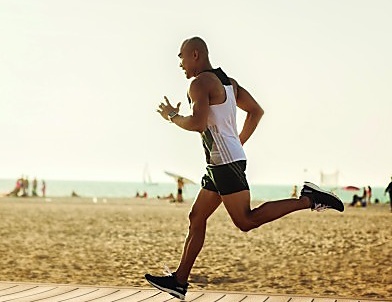Is your lower back sore during or after running? If you heel strike when you run then this is your problem! Luckily, forefoot running significantly un-stresses the lower back to the point where it brings full resolve to your running-related lower back pain.


There are 2 ways heel strike running causes lower back pain: over-striding and knee-joint stiffness, both result in poor impact absorption and increases transient vibrations on the lower back.
Over-Striding
Over-striding (shown below) means the knee-joint is extended when the foot strikes the ground [1], and tends to be more easily engaged when landing heel-first when running. This is because to land heel-first while running, the leg tends to over-reach in front of the body, causing the knee to completely unbend (knee extension). Landing this way creates a longer distance separation between initial foot strike position and the upper body (which is also the centre of mass). The problem with this landing configuration is the body comes to a crashing halt for a longer period of time than if the foot landed closer to the upper body, like it does in a forefoot strike landing.
Furthermore, landing with the foot too far in front of the hips (over-striding) alters the position of the lower back and contributes to excessive anterior pelvic tilt, which is a major risk factor for lumbar lordosis [2,3].

Knee Joint Stiffness
Knee-joint stiffness at touchdown is another problem more common in heel strike running than in forefoot running. As stated above, the knee is usually extended at heel strike which means the knee-joint is less flexed and compliant, making it less able to attenuate shock [4]. This loss of impact absorption amplifies impact to the lower back.


How Forefoot Running Protects Your Lower Back From Injury
A growing body of evidence shows that foot strike pattern when running directly influences knee-joint and leg swing mechanics whereby landing forefoot-first when running has been shown to be a significant contributor in reducing knee extensibility and the overstride angle. This can permit net impact to occur at lower intensities which is less distressing on the back.
Forefoot running engages these positive changes in mechanics because the action of landing forefoot-first when running naturally causes the knee-joint to slightly flex (bend) which actively encourages the foot to land closer to the center mass, shown below:


The final piece of good news is since the over-stride angle is naturally reduced in forefoot running via increased knee flexion at landing, keeps the position of the pelvis in a safer range, helping reduce stress on the lower back.
Evidence like this is just more confirmation that forefoot running is an exceptionally effective way to limit the impact forces most commonly linked to heel strike running which are also most commonly linked to lower back pain.
If you enjoy my blog on forefoot running, you’ll love my Run Forefoot YouTube channel here!

References:
[1]. Altman AR, Davis IS (2012) Barefoot running: biomechanics and implications for running injuries. Curr Sports Med Rep 11:244 – 50. doi:
[2]. Delgadoet al.(2013). Effects of Foot Strike on Low Back Posture, Shock Attenuation, and Comfort in Running. Med Sci Sports Exerc, 490-96.
[3]. Schache, AG., Blanch, P., Rath, D., Wrigley, T and Bennell K. (2002). Three-dimensional angular kinematics of the lumbar spine and pelvis during running.Hum Mov Sci,21:273–93.
[4]. Nicola, TL and Jewison, DJ. (2012). The anatomy and biomechanics of running. Clin Sports Med, 31(2):187–201.
[5]. Franz, JR., Paylo, KW., Dicharry, J., Riley, PO and Kerrigan, DC. (2009). Changes in the coordination of hip and pelvis kinematics with mode of locomotion. Gait Posture, 29:494–8.
[6]. Kerdok, AE., Biewener, AA., McMahon, TA., Weyand, PG and Herr, HM. (2002). Energetics and mechanics of human running on surfaces of different stiffnesses. J Appl Physiol, 92:469–78.
[7]. Hamill J., Moses M and Saey J. Lower extremity joint stiffness in runners. Res Sports Med, 2009;17(4):260-73.
If you’d like, you can support Run Forefoot and help keep it going by making a donation in any amount of your choosing:

Or, you can support Run Forefoot by shopping at the BEST Barefoot Shoe Brands, and be sure to bookmark these links 🙂
Lonowear: https://lonowear.com/?ref=cedsholh
Saguaro: https://www.saguaro.com/?ref=9bVA8fEkmDvB-I
Vibram FiveFingers: https://www.anrdoezrs.net/click-7600968-11372648
Vivobarefoot: https://amzn.to/3vycQOY
Be Lenka: https://www.tkqlhce.com/click-7600968-13947200
Xero Shoes: https://xeroshoes.com/go/Run_Forefoot
Iguaneye: https://www.iguaneye.com/?ref=8tfXVc92
Soft Star Shoes: https://shrsl.com/3mp1b
Wilding Shoes: https://bit.ly/3lIygQP
Bretta Riches
BSc Neurobiology; MSc Biomechanics candidate, ultra minimalist runner & founder of RunForefoot. I was a heel striker, always injured. I was inspired by the great Tirunesh Dibaba to try forefoot running. Now, I'm injury free. This is why I launched Run Forefoot, to advocate the health & performance benefits of forefoot running and to raise awareness on the dangers of heel striking, because the world needs to know.
Latest posts by Bretta Riches (see all)
- Can You Run In Barefoot Shoes? Yes, But DON’T Heel Strike! - 21/07/2024
- Why Cushioned Running Shoes Are Really Bad for Your Feet - 19/07/2024
- Do Cushioned Running Shoes Cause Injuries? - 17/07/2024

